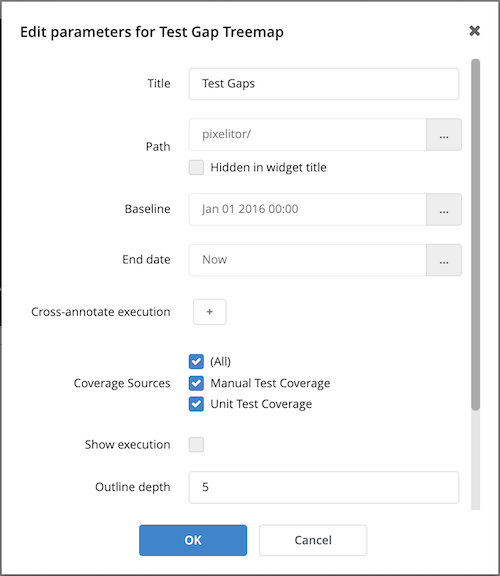How to Create a Test Gap Analysis Dashboard
Summary
To get a high-level overview of the testing state of your system, e.g., to analyze remaining test gaps before a release, we recommend to create a dashboard with a Test Gap Treemap.
Adding a Test Gap Treemap to a Dashboard
Switch to the Dashboard perspective and add a new dashboard or edit an existing one. From the right sidebar, select the Test Gap Treemap widget, to add such a widget to your dashboard.

Resize the widget by dragging the handle at its lower-right corner. Then click on the icon at the widget's upper-left corner to open the configuration dialog.

In the dialog, you have several options to determine which data is shown in the treemap:
- Title specifies the text displayed at the top of the widget.
- Path determines which part of your software system is shown in the treemap. By default, this is the entire codebase. However, if your interested in only a part of the codebase, e.g., only a component that your are responsible for, you can change this here. You may select any path from the file system or an architecture to narrow the scope. The chosen path is displayed as part of the widget title, by default. The Hidden in widget title option allows you to hide it.
- Baseline is the point in time from which on TGA considers code changes and test coverage. You may chose, for example, the beginning of your current Sprint or the last release of your software system. In any case, chose a date slightly before the first relevant change, to ensure TGA includes all changes.
- End date is the point in time until which TGA considers code changes and test coverage. Often leaving this option at
Nowis a reasonable choice, to have the TGA consider all changes and coverage since the baseline. - Cross-annotate execution allows you to use coverage information from a different Teamscale project for Test Gap analysis on this project. This is required for TGA on SAP systems and can safely be ignored for most other setups.
- Coverage Sources are the Partitions that you upload coverage to. TGA considers coverage from whichever combination of partitions you select here.
After you configured the widget, save the dashboard to start analyzing Test Gaps.
Test Gap Analysis is Branch-Specific
You always analyze Test Gaps with respect to a particular branch in your source control repository, i.e., one consecutive line of code changes. If you enabled branch support for your project, you can change this branch at the top of the dashboard at any time, without modifying the dashboard itself.
